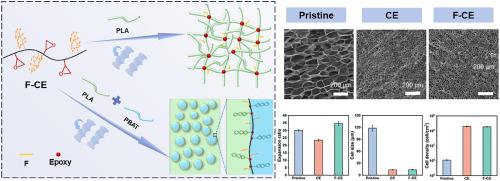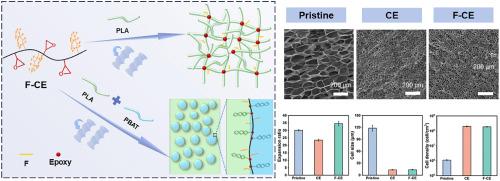CO2-philic chain extenders: Engineering interfacial activation for optimized cellular morphogenesis in biodegradable polymer foams
IF 4.5
2区 化学
Q2 POLYMER SCIENCE
引用次数: 0
Abstract
With the growing global emphasis on environmental protection, supercritical CO2 foaming technology for biodegradable materials such as polylactic acid (PLA), poly(butylene adipate-co-terephthalate) (PBAT), poly (butylene succinate) (PBS) and their blends has emerged as a research and application hotspot. However, the low melt strength and poor compatibility of these polymers often lead to low nucleation efficiency, cell wall rupture and coalescence, exhibiting inferior foaming performance. In this work, aiming to enhance the foamability of PLA and PLA/PBAT blends, a fluorinated chain extender, F-CE (GMA-co-DFHA-co-MMA), was designed and synthesized. Through the reactive melt blending, F-CE effectively enhanced the melt strength of PLA and interfacial adhesion between PLA and PBAT, leading to a significant improvement in foaming performance. Additionally, the fluorine groups in DFHA demonstrated high affinity for CO2, providing additional heterogeneous nucleation sites for bubble formation, thereby increasing both foam expansion ratio and cell density. Notably, the F-CE/PLA foam exhibited a cell diameter of ∼13.8 μm with an exceptionally high expansion ratio of ∼35. As a contrast, pristine PLA foam shows an expansion ratio of ∼30, but with large cell diameter (∼118 μm). Although PLA foam containing CE without fluorine (CE/PLA foam) exhibits small cells with an average cell diameter of ∼13.6 μm, the expansion ratio is low (∼23). In addition, F-CE also exhibits superior performance in improving the foamability of PLA/PBAT blends. This work presents a chain extender specifically engineered for foaming applications, which functions as a highly efficient foaming additive to holistically enhance the foaming performance of polymers.


亲二氧化碳扩链剂:生物可降解聚合物泡沫中优化细胞形态形成的工程界面激活
随着全球对环境保护的日益重视,聚乳酸(PLA)、聚己二酸丁二酯(PBAT)、聚丁二酸丁二酯(PBS)及其共混物等可生物降解材料的超临界CO2发泡技术已成为研究和应用热点。但由于熔融强度低,相容性差,导致成核效率低,细胞壁破裂和聚结,发泡性能较差。为了提高PLA和PLA/PBAT共混物的发泡性能,设计并合成了一种氟化扩链剂F-CE (GMA-co-DFHA-co-MMA)。通过反应性熔体共混,F-CE有效地提高了PLA的熔体强度和PLA与PBAT之间的界面附着力,发泡性能显著提高。此外,DFHA中的氟基团对CO2表现出高亲和力,为气泡形成提供了额外的异质成核位点,从而增加了泡沫膨胀率和细胞密度。值得注意的是,F-CE/PLA泡沫的孔直径为~ 13.8 μm,膨胀率高达~ 35。相比之下,原始PLA泡沫的膨胀率为~ 30,但孔直径较大(~ 118 μm)。虽然含有不含氟CE的PLA泡沫(CE/PLA泡沫)显示出平均直径为~ 13.6 μm的小细胞,但膨胀率很低(~ 23)。此外,F-CE在改善PLA/PBAT共混物的发泡性能方面也表现出优异的性能。本工作提出了一种专门为发泡应用而设计的扩链剂,它作为一种高效的发泡添加剂,可以全面提高聚合物的发泡性能。
本文章由计算机程序翻译,如有差异,请以英文原文为准。
求助全文
约1分钟内获得全文
求助全文
来源期刊

Polymer
化学-高分子科学
CiteScore
7.90
自引率
8.70%
发文量
959
审稿时长
32 days
期刊介绍:
Polymer is an interdisciplinary journal dedicated to publishing innovative and significant advances in Polymer Physics, Chemistry and Technology. We welcome submissions on polymer hybrids, nanocomposites, characterisation and self-assembly. Polymer also publishes work on the technological application of polymers in energy and optoelectronics.
The main scope is covered but not limited to the following core areas:
Polymer Materials
Nanocomposites and hybrid nanomaterials
Polymer blends, films, fibres, networks and porous materials
Physical Characterization
Characterisation, modelling and simulation* of molecular and materials properties in bulk, solution, and thin films
Polymer Engineering
Advanced multiscale processing methods
Polymer Synthesis, Modification and Self-assembly
Including designer polymer architectures, mechanisms and kinetics, and supramolecular polymerization
Technological Applications
Polymers for energy generation and storage
Polymer membranes for separation technology
Polymers for opto- and microelectronics.
 求助内容:
求助内容: 应助结果提醒方式:
应助结果提醒方式:


